The Yamal Peninsula juts up from the northern edge of Russia like a thumb sticking out into the Kara Sea. A matrix of lakes and streams stretches across the barren surface, beneath which lie layers of permafrost that can reach deeper into the ground than Moscow’s tallest buildings rise into the sky. When the temperatures drop in the winter, the waterways freeze over and the sun recedes, leaving the region shrouded in darkness for twenty hours a day. During the summer, the ice splinters, and the tundra turns into a boggy, mosquito-infested maze.
In the language of the native Nenets people, yamal means “the edge of the world.” In medieval times, outsiders took to calling the surrounding lands “midnight country.” Early travelers wrote of mountains, as high as the heavens, that sloped down to the sea and emitted unintelligible cries. Others told of a savage local tribe who served their children to guests for dinner. Explorers from the Novgorod Republic, who arrived in the eleventh century to trade iron for furs, took back with them tales of a place where little reindeer fell from the clouds and scattered across the earth.

Tikhon Kondigin and his sons Alexander and Ivan hunt reindeer near their camp in Aksarka (detail). Photographs from the Yamal Peninsula, Russia, by Davide Monteleone
Neither Yamal’s remoteness nor winters during which temperatures can reach –55° F drove the Nenets south to warmer ground. Instead, they developed a lifestyle dependent on the reindeer, which were as plentiful as the stories suggested, and well suited to the harsh northern environs. Native legend has it that the gods created reindeer just after they created man; the spirit responsible for the animals is known as Ilebyam pertya, which translates literally to “giving life.” The reindeer serve as a mode of transport, as well as a source of sustenance, warmth, and meaning. Soviet anthropologists came to study Yamal’s tribes in the early 1920s and remarked on this relationship. As one observer wrote, everyone he met there
dreams of owning his own herd and never stops collecting reindeer, he does not treat his herd as capital, as a means of obtaining profit and exploiting others (he has no notion of rational economy). . . . The nomad’s reindeer herd is his guarantee against hunger and the elements.
To this day, Nenets herders will follow their reindeer hundreds of miles each year, up and down the peninsula in search of new pastures. They come to know their animals so well that they can identify individuals in a herd of thousands. These grueling journeys along the reindeer trail have taught the Nenets to be wary of long-term plans, to recognize the fragility of their existence. Ethnographers note that they often add the phrase ta eltsyand tevba na (“if we live till then”) when discussing the future.
As the Nenets made their yearly migration north in July 2016, Andrei Listishenko, the head of Yamal’s veterinary service for the past fifteen years, began receiving puzzling messages. “It all begins with the fact that it was a very hot summer,” he told me when I visited him in Salekhard, the regional capital. Herders reported that their reindeer had become groggy and sluggish; they were falling behind and had stopped reacting to commands. “They come and immediately lie down,” one herder told local media. “They’re sleepy.” Another, Alexander Serotteto, recalled walking nine hours to reach a camp with a working satellite phone, hoping to alert the authorities that the reindeer were dying.
Initially, local officials paid the news little mind. “They’re extreme animals, they can live in almost any conditions, but extreme heat is much tougher on them than extreme cold,” Listishenko told me. His wide, flat nose, full cheeks, and rounded forehead lend his face the gentle aura of an otter. He grew up in a farming town in central Russia, surrounded by cows, pigs, and chickens, and enjoyed physics, chemistry, and biology, as well as the popular Soviet-era magazine Science and Life. His hands are so callused that they have become soft. “We thought it was heatstroke,” he recalled.
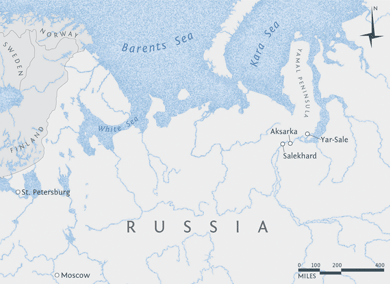
Map by Dolly Holmes
As reports from the tundra grew more urgent, Listishenko took off for Yar-Sale, a small town some 120 miles northeast of Salekhard. He made his way to the surrounding camps and saw a scene that shocked him: reindeer clustered on the ground, shaking and panting. Patches of their fur seemed to have fallen off, leaving them splotchy; the animals were emaciated, their ribs visible. “The reindeer grows feeble and exhales sharply,” Listishenko said. “The pain is visible, he drops his head because it hurts, his temperature starts rising rapidly, he’s breathing heavily, he sticks his tongue out, and, in a fit of convulsions, he dies.”
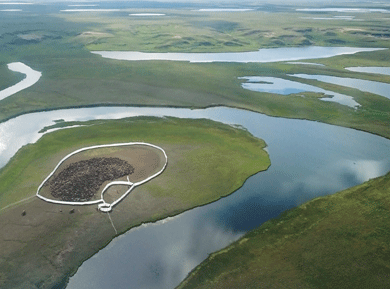
An aerial view of the tundra near Yar-Sale. After the anthrax outbreak in 2016, regional authorities vaccinated reindeer here for the first time since 2007. Photograph by Andrei Listishenko
Listishenko began to suspect that he was not facing a case of simple heatstroke. “We didn’t know the scale of it,” he said. “Every day it kept growing.” Dozens of dead reindeer became hundreds, then a thousand. The infrastructure of the region — or the lack thereof — complicated the process. “You have to understand, we’re not in Europe, where there are roads everywhere, or in Moscow, where you can get anywhere within an hour,” Listishenko continued. “Once you’re in the tundra, and your helicopter has left, that’s it — you’re one-on-one with nature.” He gathered a team and began collecting samples. They told the herders to avoid contact with the sick reindeer and tried to limit the animals’ movement while waiting for answers from laboratories in Tyumen and Moscow.
On July 25, the results arrived. They were unequivocal: anthrax.
For most of us, anthrax evokes fearful memories of white powder in envelopes. The disease, however, is an ancient one. God’s fifth plague upon the Egyptians — ‘‘Behold, the hand of the Lord is upon thy cattle which is in the field, upon the horses, upon the asses, upon the camels, upon the oxen, and upon the sheep: there shall be a very grievous murrain,” Moses told Pharaoh — may well have been an anthrax outbreak. The same goes for Apollo’s bane upon the Greeks at the beginning of the Iliad. (Homer dubbed the disease “the burning wind of plague.”) Perhaps the most striking description from antiquity of what we now know as Bacillus anthracis comes from Virgil’s Georgics:
Nor was the manner of dying a simple matter:
After the thirsty slake-seeking fever had gone
All through the veins and withered the pitiful limbs,
Then a fluid welled up in the suffering body, and
Piece by piece absorbed the melting bones.
B. anthracis is a cruel organism. In their passive form, the bacteria live as hard, oval-shaped spores with thick, nearly indestructible walls that allow them to survive for decades. When the spores colonize a victim’s bloodstream, they enter a vegetative state, dissolving their walls and gathering into neat chains that Robert Koch, the nineteenth-century German scientist whose pioneering work helped identify the disease, described as “graceful, artificially ordered strings of pearls.” In order to survive, the bacteria must kill the host and reproduce inside it before escaping back into the world and returning to a resting state.
Anthrax bacteria produce two lethal toxins in tandem, akin to those that cause tetanus and cholera. The process tends to be swift, and the chances of fatality high. The early symptoms resemble those of the common flu: your head begins to ache; your temperature rises; a general sense of weakness envelops your body; your stomach starts rumbling; you begin to cough incessantly. Then things get serious: you may go into seizures; your organs begin failing; boils break out across your skin, swelling red pustules with a trademark black center. In the fifth century bc, Hippocrates dubbed the disease anthrakes, from the ancient Greek for “charcoal.”
The disease has triumphed once the blood begins spilling from your orifices. When the medical examiners or the veterinarians cut you open, they will find that your blood has gone black, and that certain organs, particularly the spleen, have turned into masses of melting flesh.
In the nineteenth century, anthrax wreaked such havoc on cattle that the French scientist Louis Pasteur was hailed as a national hero when he developed the first vaccine. “If he succeeds,” wrote The Veterinary Press, a respected trade publication, ahead of a demonstration at the Pouilly-le-Fort fields outside Paris in 1881,
he will have endowed his country with a great benefit, and his adversaries should, as in the days of antiquity, wreathe their brows with laurel leaves and prepare to follow, chained and prostrate, the chariot of the immortal Victor.
In Yamal, the authorities were certain that they had defeated anthrax long ago. The last major outbreak took place in 1941. Surveys of some 250,000 soil samples over the past twelve years had revealed no signs of dormant spores. The regional government had stopped vaccinating reindeer in 2007 — it was a costly process that required wrangling the vast herds across a territory larger than France. “An extended period of good fortune leads people to let their guard down, their sense of worry and danger disappears, and they think that since everything has been good, it will continue to be good,” mused Yuri Selyaninov, the microbiologist whose laboratory confirmed the anthrax diagnosis.
As word of the outbreak spread across the peninsula, so did ever-wilder theories regarding its origins. Some suggested that the anthrax was the work of foreign agents aiming to weaken Russia’s defenses in the Arctic. “They say that foreigners spread the infection from an airplane,” one local told Novaya Gazeta, an opposition newspaper. Another widespread idea held that there was no anthrax at all, and in fact, the state gas giant, Gazprom, had poisoned the reindeer in an effort to drive the herders off potentially lucrative lands.
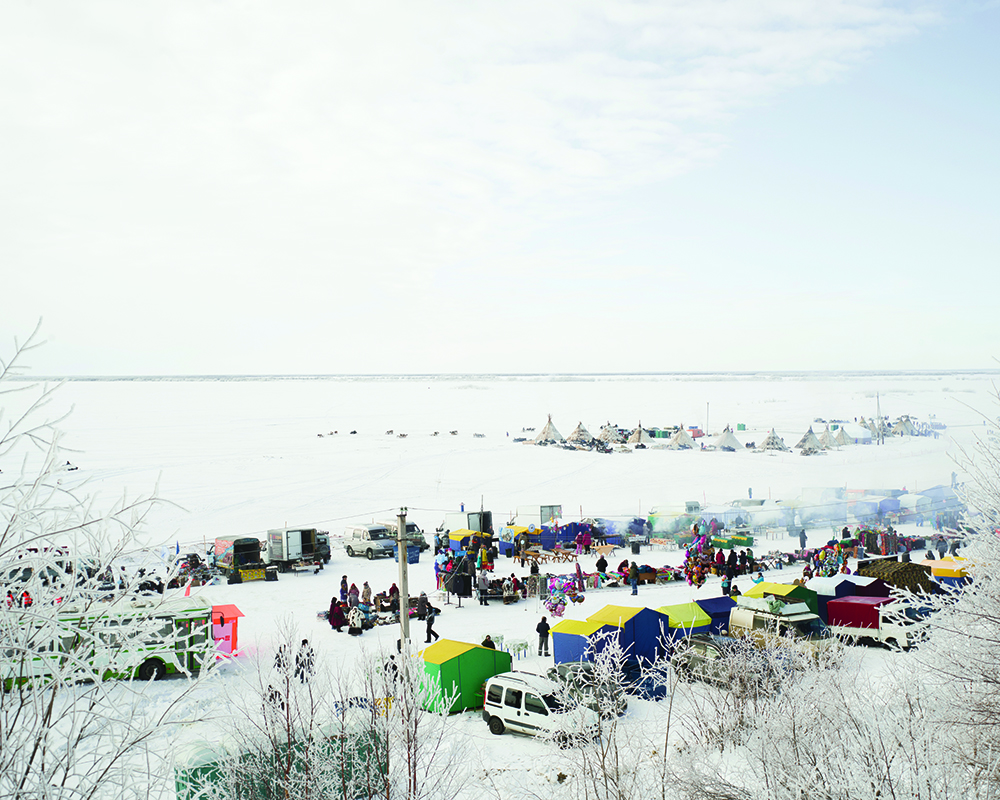
A celebration in Salekhard, the regional capital, for Den’ Olenevoda (Reindeer Herder’s Day), which is celebrated across the peninsula in March and April
On the day the diagnosis was delivered, the Yamal regional governor, Dmitry Kobylkin, declared a state of emergency and called in the Russian Army’s Radiological, Chemical, and Biological Defense forces to impose a quarantine. Hundreds of soldiers arrived on the peninsula on four-engine IL-76 military transport planes with blue stripes painted across their bellies and the Russian Army’s red star stamped on their tail fins. They brought mobile laboratories and drones. Donning gray hazmat suits and gas masks, they took off in helicopters, scouring the tundra for dead reindeer. When they found one, small teams would descend to light bonfires of burning tires around the body.
The disease, doctors found, had also spread beyond the reindeer, infecting the herders themselves. The Nenets’ customs had played a trick on them: when they kill a reindeer, rather than slitting its throat, they strangle it, carefully slice it open, and drink the still-warm blood pooled inside. The blood is an important source of nutrients in their meager diet, but it may have also given the anthrax bacteria a pathway into the human body.
Those inside the infected areas had to give up their possessions — clothes, sleighs, tents, boots — to be disinfected or incinerated. Officials set up aid stations in villages across the peninsula. Galina Mataras, a local activist, spent her days distributing supplies in herders’ camps deep in the tundra. “Imagine you have an apartment,” she told me. “And suddenly, from above, your neighbor floods you, having left the faucet on. You return home, and all of your property is not even ninety percent, but one hundred percent useless,” she continued. “You open the door, and you understand that, at that moment, you’re no one, you have nothing. That’s what these people went through. In a moment, they lost everything.”
Volunteers collected supplies — food, clothes, and tools — to help replace what was lost. Well-wishers from around the region, perhaps unaware of the conditions inside the quarantine zone, sent electric teakettles, sets of shot glasses, and summer dresses. Someone even sent an old electric meat grinder. Sandra Serotteto, Mataras’s daughter and a youth activist, helped lead the aid-collection efforts. During the early days, she barely slept. “There was panic,” she recalled. “Then that guy, Russia’s main anthrax specialist, showed up,” she said. “The Jolly Milkman.”
Vasily Seliverstov had just begun a shift as the in-house veterinarian at an Auchan supermarket on the outskirts of Moscow when he learned that the situation in Yamal had turned critical. An old comrade from the national veterinary service called to alert him. “He said, ‘Get ready and get over here.’ I flew that evening,” he told me.
True to the nickname Sandra Serotteto used, Seliverstov vaguely resembles the Jolly Milkman, the mascot of a popular Siberian dairy brand. He has a bowling ball of a head, with silvery tufts of hair around the edges, and sports a voluminous white handlebar mustache, as thick as a young reindeer’s antlers. The style has been a fixture for him since the late 1970s, when he returned, unshaven, from a month in the mountains of Tuva, in southern Siberia. “My grandmother told me, ‘Don’t shave your beard, you look like Jesus, it’s a good look for you.’ ” Sanitary restrictions forbade beards in his laboratory, so the stubborn vet stopped going to work for a month or two, until the director called and said, “Stop being an idiot, shave your beard.” Seliverstov shaved his beard but left the mustache.
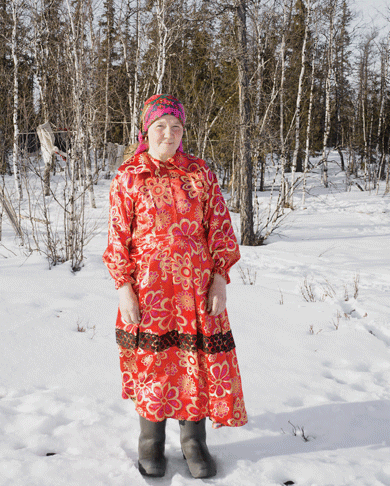
Fedosia Nogo, a reindeer herder, at her camp near Salekhard
Despite his stubbornness, or perhaps because of it, Seliverstov built a successful career in the Soviet and then the Russian national veterinary services, eventually rising to become deputy director. He specialized in anthrax, known in Russian as sibirskaya yazva, or the Siberian Sore. As a young researcher, he had been called in to help with a 1979 anthrax outbreak in Sverdlovsk, where the government was conducting top-secret experiments with chemical weapons. “Lots of people died there,” Seliverstov told me. “Who and how many died, only the KGB knows.”
Yet the new outbreak stunned even him. How could a disease that had not touched the region for three quarters of a century suddenly reemerge? “I was certain that sibirka wouldn’t appear there anymore,” he said.
After he arrived in Salekhard, Seliverstov spent seventeen days circling the tundra, overseeing vaccinations and attempting to trace the path of the outbreak. On the second day, he met Listishenko at a herders’ camp and suggested that they walk along the route that the diseased reindeer had trodden. “We walked some five kilometers that way,” Seliverstov said. They found dozens of reindeer lying dead in a row. “The thing about reindeer is that they don’t stand in place. They’re constantly moving. . . . So when the animals begin to die, they fall like a trail behind the moving herd,” he went on. “Those become future infection sites.” They’re known as morovie polya, or “cursed fields.”

Den’ Olenevoda celebration, Salekhard
Workdays in the cursed fields began at seven. The helicopters took off, and “we returned to sleep when God allowed,” Seliverstov said. Specialists set up mobile corrals, some 300 meters of canvas fencing, and wrangled the healthy reindeer toward veterinarians waiting with the vaccine. They tried to explain to the herders that anthrax could be prevented. “I always say, you don’t need to blow on cold milk — you won’t get burned,” Seliverstov told me. The state replaced the reindeer and equipment the herders had lost, and also restored mandatory vaccinations, hoping to fend off future episodes. In Salekhard, officials held regular meetings, reporting back to Moscow. According to Grigory Ledkov, the head of the Russian Association of Indigenous Peoples of the North and Yamal’s representative in the Duma, even President Vladimir Putin kept tabs on the situation.
Around the world, anthrax outbreaks are not uncommon, but most affect only a handful of animals, and very rarely do they infect any humans. (Even newsworthy cases, such as a recent spate of hippo deaths in Namibia, involve at most a few hundred creatures.) By the time the Yamal infection had been neutralized and the quarantine lifted, in late August 2016, more than 2,300 reindeer had fallen across the peninsula. Scores of humans had been hospitalized. A twelve-year-old boy, Denis, died on August 1. “God knows, from the first day, we took no chances. We did everything possible to save the lives of everyone who found themselves in trouble,” Governor Kobylkin told local media. “But the infection proved wily.”
I arrived in Yamal in March 2017, during a yearly holiday known as Den’ Olenevoda, or Reindeer Herder’s Day, which is celebrated in towns and cities across the peninsula over several weeks in March and April, as the Arctic begins to emerge from its winter slumber. On a cold day in the tundra, all you can see are swaths of white with no horizon. Frost seems to emanate from somewhere deep in the ground. Mikhail Sumgin, the Soviet researcher responsible for the term “permafrost,” also referred to it as the “Russian sphinx,” a metaphor that, as the historian Pey-Yi Chu writes, “cast nature simultaneously as an enemy to be conquered, a mystery to be unraveled, and a trove of wealth to be unlocked.”
In Salekhard, herders came from miles around to mingle with city folk, oilmen, and curious visitors along a stretch of frozen river south of the city. The gathering felt like a cross between a bazaar and a county fair. From a central stage perched atop the riverbank, an emcee addressed revelers: “The scientists say that it’s becoming warmer because of global warming! But the warmth is in our hearts and our souls! We’re all here, and the sun is here, too!” A thumping EDM soundtrack warmed up the crowd for an appearance by Kobylkin. “We are always proud to say that Yamal has the largest herd of reindeer in the world!” he crowed, to thunderous applause.
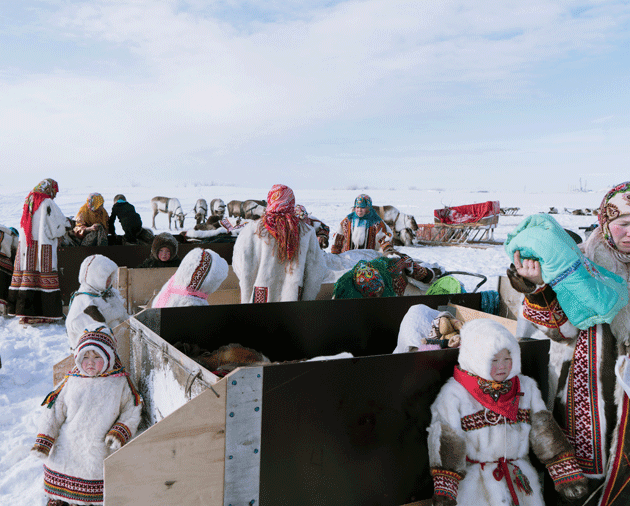
Den’ Olenevoda celebration, Salekhard
Close to the stage, a line of Nenets women hawked the wares of the far north: fox pelts, fur boots, and whole white hares. One offered me a black-and-gray wolf hide for 20,000 rubles (some $350). “We slew it ourselves,” she boasted, revealing a row of silver and gold teeth. I asked what the holiday meant for the herders, expecting an answer about family or community or the spirit world. “A chance to trade!” she replied. In the tundra, there are no country stores.
Beyond the merchants stood an Angry Birds carnival game, where young children used a slingshot twice their size to fling inflatable bird heads at a target. Men grilled pork shashlik over open coals. Frozen fish with glazed eyes — muksun, mostly — rested in buckets inside idle trucks. At the outer edge of the festival grounds, toward the middle of the river, stood a ring of traditional Nenets tents, conical constructions made by wrapping reindeer hides around long wooden poles.
Nearby, I met the head of a reindeer herders’ union, who had dressed up for the occasion, donning a full set of traditional robes — navy-blue with red, white, and turquoise trim. He wore them over a thick coat of reindeer fur, which makes a North Face parka feel like a windbreaker. I asked him and his wife what they thought the previous summer meant for the region’s future. “If the reindeer start going, life itself will disappear,” she said wistfully.
Many others, however, reacted to the outbreak with incredulity. I asked a group of students how they had been affected. Alisa, a law student from Yar-Sale whose parents had been herding near the infection zone, scoffed. “There was no anthrax,” she said with certainty. Her theory was that Gazprom wanted to build a road. I heard echoes of this skepticism throughout the week: “They spread powder from helicopters,” another student told me; “There’s oil there,” declared a third. Even a veteran of the local forestry service answered my question about the outbreak with scorn: “Do you really believe in the anthrax?”
There was little doubt about one element of the saga: as Listishenko had told me, the summer had been hot. It was, in fact, the hottest in Yamal since monitoring began in 1861, with temperatures peaking at 100° F. (Typically, summer temperatures hover around 60° F.) Russia has been warming since the mid-1970s, at a rate some 2.5 times faster than the global average, and the acceleration has been most pronounced in the Arctic regions. Unsurprisingly, the landscape has responded. The herders “understand that something’s happening to nature,” said Roza Laptander, a Nenets ethnographer. “The herders say, ‘Something strange is happening to the tundra.’ ”
Some of the changes have been subtle, such as shifts in feeding and migration patterns, or the texture of the snow. Others have been impossible to miss, such as bits of land that have started to ripple — imagine your back yard suddenly attaining the quality of an air mattress. Locals have taken to calling the phenomenon zhivaya zemlya, or “living earth.” Then there are the giant sinkholes that have opened up across the peninsula in recent years, some as wide as a hundred feet and deeper than a twenty-story building. Scientists reckon that these result from “methane bombs,” pockets of greenhouse gases that build up in the permafrost as a result of rising temperatures — a feedback loop that could drastically increase the rate of climate change. From above, the earth appears to be collapsing in on itself.
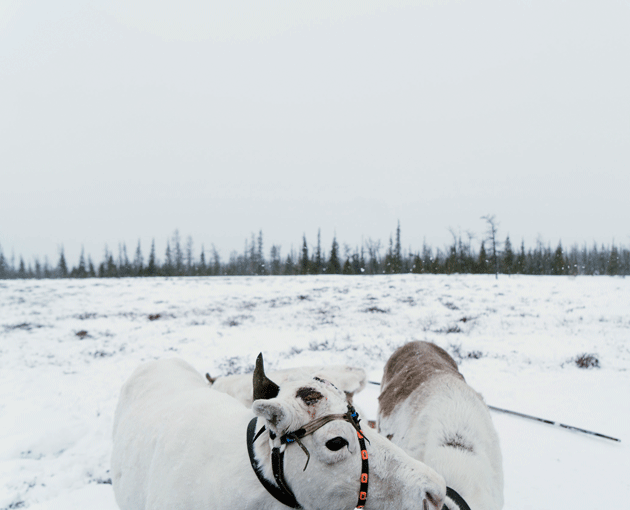
Reindeer, Aksarka
Climate change also lies behind the most credible explanation for anthrax’s return. You might call it the zombie theory. It goes something like this: The corpses of reindeer infected with the disease decades or centuries ago were preserved in the upper layers of the peninsula’s permafrost, keeping the resilient spores alive. As temperatures have soared, the permafrost has begun to thaw ever deeper, exposing the ancient grave sites and giving the spores a pathway back to the surface, where they can once again rise up to infect the living.
Researchers caution against blaming the Yamal outbreak wholly on rising temperatures, noting that a number of factors had to converge. Native traditions, the poor infrastructure, and a lack of vaccination — all somewhat specific to the region — each played a role. Yet there is no denying that absent the abnormal heat, anthrax would not have returned to Yamal. As Yuri Selyaninov and his colleagues wrote in the definitive report on the Yamal outbreak and its origins,
It has been established that the appearance of anthrax was stimulated by the activation of “old” infection sites following anomalously high air temperature and the melting of the sites to a depth beyond normal levels.
Normally, the upper layer of permafrost melts about twenty to thirty centimeters; in 2016, it receded more than a meter and a half in certain areas of Yamal. “The bacteria sleep as if they’re frozen,” Selyaninov explained to me. “Then the temperature went up, and the bacteria received a signal that the surroundings had become favorable. It was warm, and there was something to eat.”
In a sense, these auspicious conditions had their roots in the region’s booming petroleum industry. The depths of Yamal contain, in addition to sleeping spores, some of the world’s largest known gas reserves — perhaps as much as one quarter of the global deposits — and a large chunk of the planet’s oil too. The Soviet Union began inspecting potential deposits in the late 1950s, and early prospectors marveled at the untold riches. “The generosity of the bowels of the Yamal tundra turned out to be truly limitless!” wrote Arkady Kraev, a geophysicist who helped drill many of the first probes for the Soviet Ministry of Gas Industry. Development of the Yamal fields continued, often to the detriment of reindeer pastures. Following the collapse of the Soviet Union, the ministry morphed into Gazprom, one of the world’s largest energy companies and a crown jewel of the modern Russian state. Gazprom now pumps some 67.5 billion cubic meters of gas from Yamal each year, with plans to expand to 360 billion as new fields are tapped.
Russia is one of the world’s largest producers of oil and gas, its fourth-largest carbon emitter, and its largest Arctic nation. While Moscow has reluctantly accepted the science of climate change, the Kremlin is hardly clamoring to do much in response. Vladimir Putin signed the Paris climate accord, but Russia has yet to ratify it. What’s more, the targets that the government set for itself are little more than a sleight of hand: as a baseline standard from which to reduce emissions, Russia chose the year 1990, when the centrally planned Soviet economy kept heavy industry running at an inordinate clip. Cutting emissions by 25 to 30 percent from those levels by 2030 would actually mean an increase from today’s output.
Russia’s reluctance to act is in large part a function of the economy’s overdependence on fossil fuels, which account for more than 60 percent of the country’s exports. But it also reflects the sense that climate change may actually prove to be a boon for the country. Researchers at Stanford and UC Berkeley have predicted that while climate change will shrink global GDP per capita by 23 percent by the end of the century, Russia’s GDP will grow by more than 400 percent — more than for any country other than Finland, Iceland, and Mongolia. As the far north melts, the theory goes, it will become more hospitable, and its treasures more accessible. “Climate change provides more favorable conditions for economic activity in this region,” Putin told a group of business and government bigwigs at a forum on Arctic issues in early 2017.
But if warming temperatures herald a windfall for Russia’s oil and gas industries, they also threaten further epidemics for the inhabitants far north. In a prescient 2011 article, Boris Revich, an environmental epidemiologist at the Russian Academy of Sciences, warned of this bizarre but potentially lethal development:
As a consequence of permafrost melting, the vectors of deadly infections of the eighteenth and nineteenth centuries may come back, especially near the cemeteries where the victims of these infections were buried.
Recent research has uncovered a number of specific threats. From mass graves in the Alaskan tundra, scientists have uncovered fragments of the virus that caused the 1918 outbreak of the Spanish flu. In 2013, the French microbiologists Jean-Michel Claverie and Chantal Abergel discovered still-active viruses in a 30,000-year-old slice of Siberian permafrost. Though their sample could not affect humans, their study suggests that other, more infectious viruses may be lurking. Some frozen microbes may even carry diseases that our immune systems no longer know how to fight. Specialists also caution that devastating eradicated diseases such as smallpox could be preserved in the ice. Many researchers see the Yamal outbreak as a sign of things to come. “It’s a warning of sorts that the situation with preserved infections infiltrating our modern world may get much worse if we do not address the problem,” argued Boris Kershengoltz, the chief of research at the Russian Institute for Biological Problems of the Permafrost Zone.
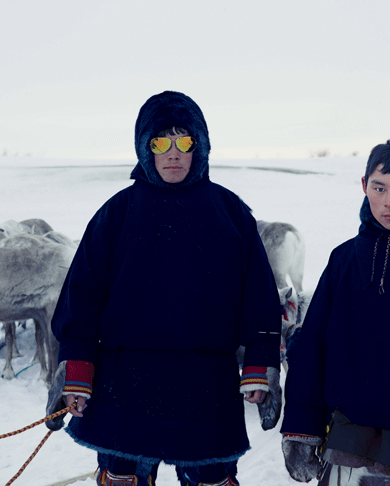
Two young herders, Salekhard
An uncanny symmetry links this problem to the traditional Nenets understanding of the origins of disease. Nenets shamans speak of a world split into three realms: the upper world is home to Noom, the creator spirit; the middle world is the earth itself, home to humans and animals; the lower world belongs to Nga, Noom’s brother, the spirit of death and disease. This lower world consists of seven layers of ice, and during times of trouble, the spirits of sickness rise from the frost. The Russian term for permafrost — vechnaya merzlota — literally means “the eternally frozen ground.” Revich has stopped using it. “It’s clearly not eternal anymore,” he told me.
Most of those I met in Yamal acknowledged that their surroundings were changing, and probably not for the best. But that seldom extended to linking those processes with the oil and gas apparatus that now extends across the peninsula. Few people entertained the notion that after decades of drilling into the earth’s heart and laying pipes under her skin, she might be beginning to fight back.
Even the herders, who bemoan the oil industry’s expansion, are not immune to the allure of capital. Inside traditional tents in the tundra, one can often find TVs glowing and teenagers glued to cell phones. At Den’ Olenevoda, most of the reindeer I saw had had their antlers axed off. The fresh scars felt like the bark of a knotty tree, or the scab on a child’s scraped knee. I asked one herder why he had done it. “Money,” he said with a smile. “Hard currency.” A kilo of antler bone, he told me, brought him 650 rubles (roughly $11), and each set of antlers he sold weighs about five. (The main buyers are Chinese, he added, who use powdered reindeer antler, among other things, as an aphrodisiac; they also make up most of the market for reindeer penis and tail, which they co-opt for similar purposes — or so the herder told me with a snicker.)
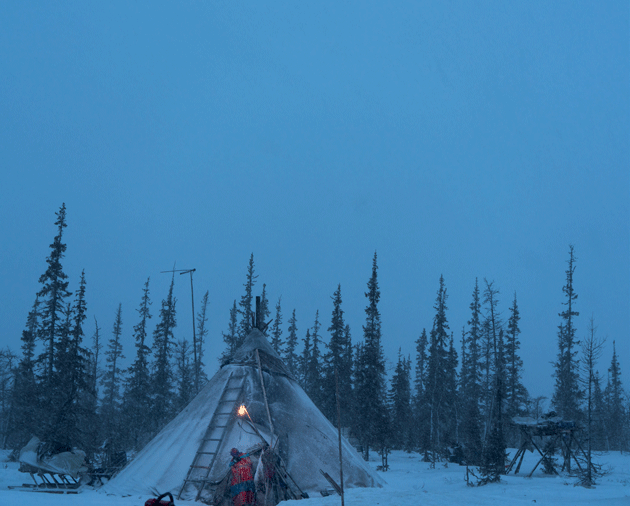
Tikhon Kondigin’s camp, Aksarka
Midway through the festival, I approached a racetrack that stretched along the river, between the stage and the tents. Solemn-looking men and women wrapped in fur steered their sleighs toward the starting line. They directed the writhing reindeer, five to a team, with reins and long poles that they used to poke at their legs, urging them to gallop ever faster. Sometimes the riders howled, imitating wolves. The sleighs careered across the snow, and the elongated torsos of the reindeer rippled like flags in a stiff wind. They have immense eyes, the reindeer, the size of golf balls, and long pink tongues that protrude when they get tired. Their legs are skinny, considering the distances they cover each year. In barely more than a minute, the first teams had already completed the kilometer-long circuit. They had been racing, I later learned, for the grand prize of a brand-new Stels snowmobile.
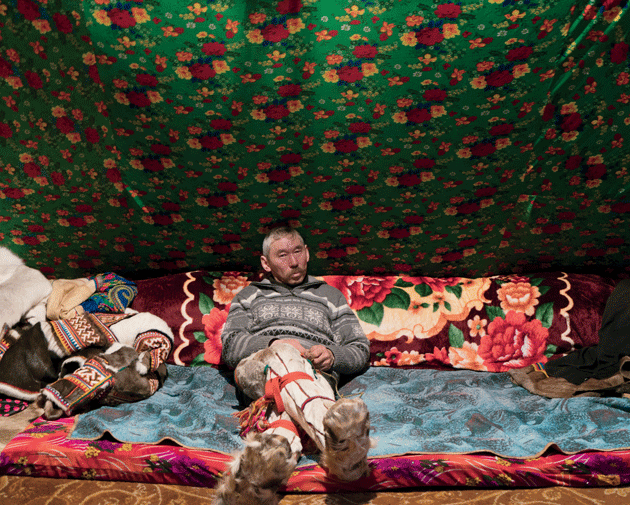
Tikhon Kondigin inside his tent
After the last of the sleighs had crossed the finish line, after the tents had been dismantled and the herders had returned to the tundra, I went for a drink in town. Perhaps unsurprisingly, I was recommended a place called Bar Neft, “Oil Bar.” Bar Neft sits on the outskirts of Salekhard, in an old industrial neighborhood. The entrance resembles a giant black oil barrel, with a door carved into the right-hand side. The employees all wore black balaclavas. “Do you have a pistol?” the bouncer asked at the entrance. I shook my head. “You’re not from here, are you?” he replied.
A message had been posted on the door inside: sanctions! us president barack obama is forbidden from entering. Yet behind the bar hung a string of vintage American license plates: Illinois, Alabama, Delaware, New Mexico. On one wall was a homey sign written in English: money can’t buy happiness but it can buy marshmallows, which are almost the same thing. On another wall, imposing black graffiti declared, without a hint of irony, oil is our everything. The cognitive dissonance seemed lost on the patrons. The speakers spit out a string of Aughts classics, heavy on the 50 Cent:
My flow, my show brought me the dough
That bought me all my fancy things,
My crib, my cars, my pools, my jewels.
The crowd stirred, and I could not help joining in. We all swayed, oblivious to the air around us and the ground below us.






































































































